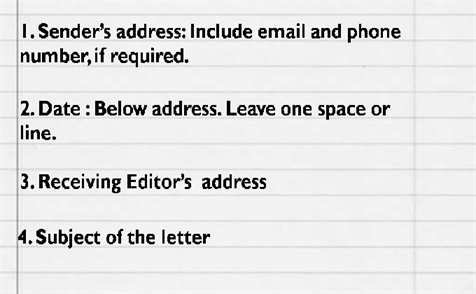Letter to the Editor Format - CBSE Class 9, 10, 12
Let us discuss the format of a Letter to the Editor.
The format of a letter to the editor of a Newspaper is as follows –
1. Sender’s address: The address and contact details of the sender are written here. Include email and phone number, if required or if mentioned in the question.
2. Date: The date is written below the sender’s address after Leaving one space or line.
3. Receiving Editor’s address: The address of the recipient of the mail i.e. the editor is written here.
4. Subject of the letter: The main purpose of the letter forms the subject. It must be written in one line. It must convey the matter for which the letter is written.
5. Salutation (Sir / Respected sir / Madam)
6. Body: The matter of the letter is written here. It is divided into 3 paragraphs as follows -
Paragraph 1: Introduce yourself and the purpose of writing the letter in brief.
Paragraph 2: Give a detail of the matter.
Paragraph 3: Conclude by mentioning what you expect from the editor. (For example, you may want him to highlight the issue in his newspaper / magazine).
7. Complimentary Closing
8. Sender’s name, signature and designation(if any)
The format of a letter to the editor of a Newspaper is as follows –
1. Sender’s address: The address and contact details of the sender are written here. Include email and phone number, if required or if mentioned in the question.
2. Date: The date is written below the sender’s address after Leaving one space or line.
3. Receiving Editor’s address: The address of the recipient of the mail i.e. the editor is written here.
4. Subject of the letter: The main purpose of the letter forms the subject. It must be written in one line. It must convey the matter for which the letter is written.
5. Salutation (Sir / Respected sir / Madam)
6. Body: The matter of the letter is written here. It is divided into 3 paragraphs as follows -
Paragraph 1: Introduce yourself and the purpose of writing the letter in brief.
Paragraph 2: Give a detail of the matter.
Paragraph 3: Conclude by mentioning what you expect from the editor. (For example, you may want him to highlight the issue in his newspaper / magazine).
7. Complimentary Closing
8. Sender’s name, signature and designation(if any)


Comments
Post a Comment